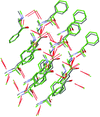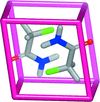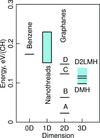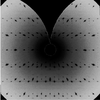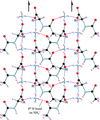issue contents
August 2016 issue
Special issue on Crystal structure prediction
Guest Editors: Graeme M. Day and Carl Henrik Görbitz

Cover illustration: Schematic of the crystal structure prediction of the multicomponent system of 3,5-dinitrobenzoic acid and Tröger's base, which was system (XXV) in the sixth blind test of crystal structure prediction methods. (XXV) was successfully predicted as a co-crystal in five submissions, starting only from the two-dimensional diagrams of the two components. While predicted as a co-crystal, low-temperature diffraction data suggest the proton is disordered between the two components [see Reilly et al. (2016). Acta Cryst. B72, 439-459].
editorial

scientific commentaries

feature articles
 access
accesscrystal structure prediction
 access
access access
accessExploring polymorphism of benzene and naphthalene with free energy based enhanced molecular dynamics


research papers






 access
access





 journal menu
journal menu












